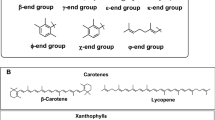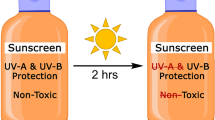Abstract
Photoprotection by dietary carotenoids has been linked to their antioxidant properties, in particular quenching of singlet molecular oxygen and scavenging of peroxyl radicals. Here, we compared the DNA-protection and antioxidant effects of selected carotenoids exclusively synthesized in red pepper (capsanthin and capsorubin) to the xanthophyll lutein. Preincubation of human dermal fibroblasts (hdf) with capsanthin and capsorubin significantly counteracted UVB induced cytotoxicity at doses between 0 and 300 mJ cm-2. Pretreatment of hdf with capsanthin, capsorubin or lutein (1 μM) significantly decreased the formation of DNA strand breaks following irradiation with UVB light. All carotenoids studied decreased caspase-3 cleavage (a marker for UVB-induced apoptosis), however, caspase dependent PARP-1 cleavage was not affected suggesting that the remaining caspase activity is sufficient to promote UVB-induced apoptosis. It is conceivable that carotenoids selectively interfere with cellular responses activated by UVB-mediated damage. Our findings indicate that capsanthin and capsorubin exhibit similar properties to lutein and could be used as a dietary supplement to improve natural photoprotection.
Similar content being viewed by others
References
E. Boelsma, H. F. Hendriks, L. Roza, Nutritional skin care: health effects of micronutrients and fatty acids, Am. J. Clin. Nutr., 2001, 73, 853–864.
W. Stahl, H. Sies, ß-carotene and other carotenoids in protection from sunlight, Am. J. Clin. Nutr., 2012, 96, 1179S–1184S.
G. J. Fisher, S. C. Datta, H. S. Talwar, Z. O. Wang, J. Varani, S. Kang, J. J. Voorhees, Molecular basis of sun-induced premature skin ageing and retinoid antagonism, Nature, 1996, 379, 335–339.
J. Wenk, P. Brenneisen, C. Meewes, M. Wlaschek, T. Peters, R. Blaudschun, W. Ma, L. Kuhr, L. Scheneider, K. Scharffetter-Kochanek, UV-induced oxidative stress and photoaging, Curr. Probl. Dermatol., 2001, 29, 83–94.
E. Kohl, J. Steinbauer, M. Landthaler, R. M. Szeimies, Skin ageing, J. Eur. Acad. Dermatol. Venereol., 2011, 25, 873–884.
M. Wlaschek, I. Tantcheva-Poór, L. Naderi, W. Ma, L. A. Schneider, Z. Razi-Wolf, J. Schüller, K. Scharffetter-Kochanek, Solar UV irradiation and dermal photoaging, J. Photochem. Photobiol., B, 2001, 63, 41–51.
Y. Yin, W. Li, Y.-O. Son, L. Sun, J. Lu, D. Kim, X. Wang, H. Yao, L. Wang, P. Pratheeshkumar, A. J. Hitron, J. Luo, N. Gao, X. Shi, Z. Zhang, Quercitrin protects skin from UVB-induced oxidative damage, Toxicol. Appl. Pharmacol., 2013, 269, 89–99.
G. De Ríos, J. T. Chan, H. S. Black, A. H. Rudolph, J. M. Know, Systemic protection by antioxidants against UVL-induced erythema, J. Invest. Dermatol., 1978, 70, 123–125.
W. Stahl, H. Sies, Carotenoids and flavonoids contribute to nutritional protection against skin damage from sunlight, Mol. Biotechnol., 2007, 37, 26–30.
H. Sies, W. Stahl, Nutritional protection against skin damage from sunlight, Annu. Rev. Nutr., 2004, 24, 173–200.
R. Goralczyk, and K. Wertz, in Carotenoids, ed. G. Britton, H. Pfander and S. Liaaen-Jensen, Birkhäuser Verlag, Basel, 2009, pp. 335–362.
F. Khachik, C. J. Spongler, J. C. Smith, L. M. Canfield, A. Steck, H. Pfander, Identification, quantification, and relative concentrations of carotenoids and their metabolites in human milk and serum, Anal. Chem., 1997, 69, 1873–1881.
W. Stahl, A. R. Sundquist, M. Hanusch, W. Schwarz, H. Sies, Separation of ß-carotene and lycopene geometrical isomers in biological samples, Clin. Chem., 1993, 39, 810–814.
B. H. Davies, S. Matthews, J. T. O. Kirk, The nature and biosynthesis of the carotenoids of different color varieties of Capsicum annuum, Phytochemistry, 1970, 9, 797–805.
A. Pérez-Gálvez, M. I. Mínguez-Mosquera, Degradation of non-esterified and esterified xanthophylls by free radicals, Biochim. Biophys. Acta, 2002, 1569, 31–34.
S. Beutner, B. Bloedom, S. Frixel, I. Hernandez-Blanco, T. Hoffmann, H. D. Martin, B. Mayer, P. Noack, C. Ruck, M. Schmidt, I. Schulke, S. Sell, H. Ernst, S. Haremza, G. Seybold, H. Sies, W. Stahl, R. Walsh, Quantitative assessment of antioxidant properties of natural colorants and phytochemicals: carotenoids, flavonoids, phenols and indigoids. The role of ß-carotene in antioxidant functions, J. Sci. Food Agric., 2001, 81, 559–568.
S. Wagener, T. Völker, S. De Spirt, H. Ernst, W. Stahl, Dihydroxyisorenieratene and isorenieratene prevent UV-induced damage in human skin fibroblasts, Free Radicals Biol. Med., 2012, 53, 457–463.
M. I. Mínguez-Mosquera, B. Gandul-Rojas, J. Garrido-Fernández, L. Gallardo-Guerrero, Pigments present in virgin olive oil, J. Am. Oil Chem. Soc., 1990, 67, 192–196.
M. I. Mínguez-Mosquera, D. Hornero-Méndez, Separation and quantification of the carotenoid pigments in red peppers (Capsicum annuum L.), paprika, and oleoresin by reversed-phase HPLC, J. Agric. Food Chem., 1993, 41, 1616–1620.
M. I. Mínguez-Mosquera, in Clorofilas y Carotenoides en Tecnología de Alimentos, ed. M. I. Mínguez-Mosquera, Secretariado de publicaciones de la Universidad de Sevilla, Sevilla, Spain, 1997, pp. 159–162.
P. Skehan, R. Storeng, D. Scudiero, A. Monks, J. McMahon, D. Vistica, J. T. Warren, H. Bokesch, S. Kenney, M. R. Boyd, New colorimetric cytotoxicity assay for anticancer-drug screening, J. Natl. Cancer Inst., 1990, 82, 1107–1112.
M. H. Green, J. E. Lowe, C. A. Delaney, I. C. Green, Comet assay to detect nitric oxide-dependent DNA damage in mammalian cells, Methods Enzymol., 1996, 269, 243–266.
S. Sauvaigo, C. Serres, N. Signorini, N. Emonet, M. Richard, J. Cadet, Use of single-cell gel electrophoresis assay for the immunofluorescent detection of specific DNA damage, Anal. Biochem., 1998, 259, 1–7.
S. J. Baker, E. P. Reddy, Modulation of life and death by the TNF receptor superfamily, Oncogene, 1998, 17, 3261–3270.
S. Salucci, S. Buratttini, M. Battistelli, V. Baldassarri, M. C. Maltarello, E. Falcieri, Ultraviolet B (UVB) irradiation-induced apoptosis in various cell lineages in vitro, Int. J. Mol. Sci., 2012, 14, 532–546.
S. Salucci, S. Burattini, M. Battistelli, F. Buontempo, B. Canonico, A. M. Martelli, S. Papa, E. Falcieri, Tyrosol prevents apoptosis in irradiated keratinocytes, J. Dermatol. Sci., 2015, 80, 61–68.
H. D. Martin, S. Kock, R. Scherrers, K. Lutter, T. Wagener, C. Hundsdörfer, S. Frixel, K. Schaper, H. Ernst, W. Schrader, H. Görner, W. Stahl, 3, 3′-Dihydroxyisorenieratene, a natural carotenoid with superior antioxidant and photoprotective properties, Angew. Chem., Int. Ed., 2009, 48, 400–403.
K. Lutter, S. De Spirt, S. Kock, K. Kröncke, H. D. Martin, T. Wagener, W. Stahl, 3, 3’-Dihydroxyisorenieratene prevents UV-induced formation of reactive oxygen species and the release of protein-bound zinc ions in human skin fibroblasts, Mol. Nutr. Food Res., 2010, 54, 285–291.
J. Cadet, E. Sage, T. Douki, Ultraviolet radiation-mediated damage to cellular DNA, Mutat. Res., 2005, 571, 184–190.
J. A. Evans, E. J. Johnson, The role of phytonutrients in skin health, Nutrients, 2010, 2, 903–928.
W. I. Gruszecki, K. Strzalka, Carotenoids as modulators of lipid membrane physical properties, Biochim. Biophys. Acta, 2005, 1740, 108–115.
E. Bossy-Wetzel, D. R. Green, Caspases induce cytochrome c release from mitochondria by activating cytosolic factors, J. Biol. Chem., 1999, 274, 17484–17490.
Author information
Authors and Affiliations
Corresponding author
Additional information
Electronic supplementary information (ESI) available.
Rights and permissions
About this article
Cite this article
Fernández-García, E., Carvajal-Lérida, I. & Pérez-Gálvez, A. Carotenoids exclusively synthesized in red pepper (capsanthin and capsorubin) protect human dermal fibroblasts against UVB induced DNA damage. Photochem Photobiol Sci 15, 1204–1211 (2016). https://doi.org/10.1039/c6pp00134c
Received:
Accepted:
Published:
Issue Date:
DOI: https://doi.org/10.1039/c6pp00134c




